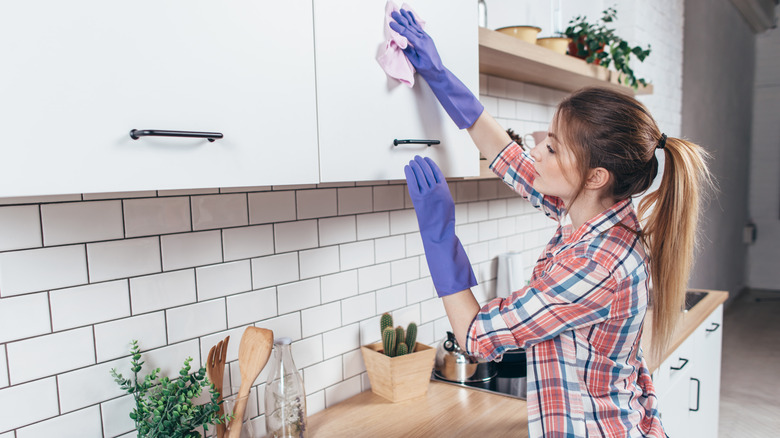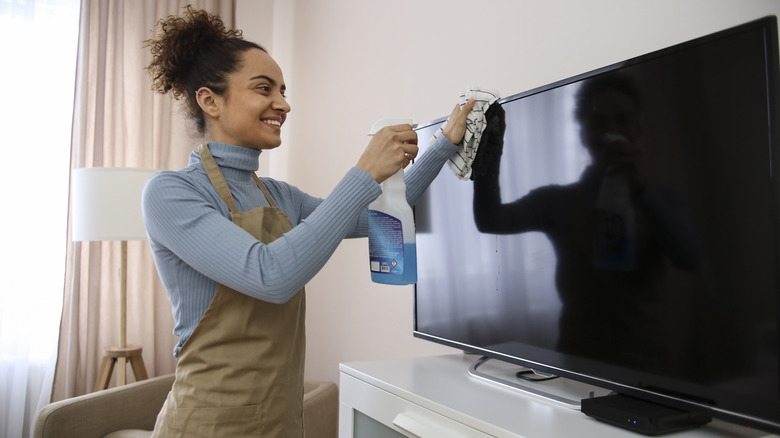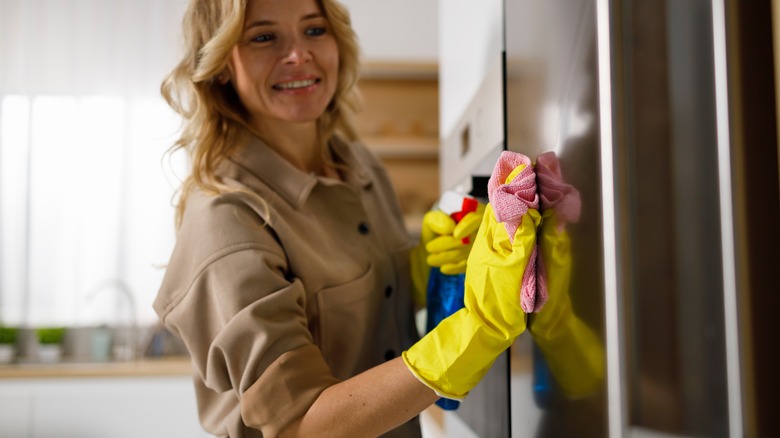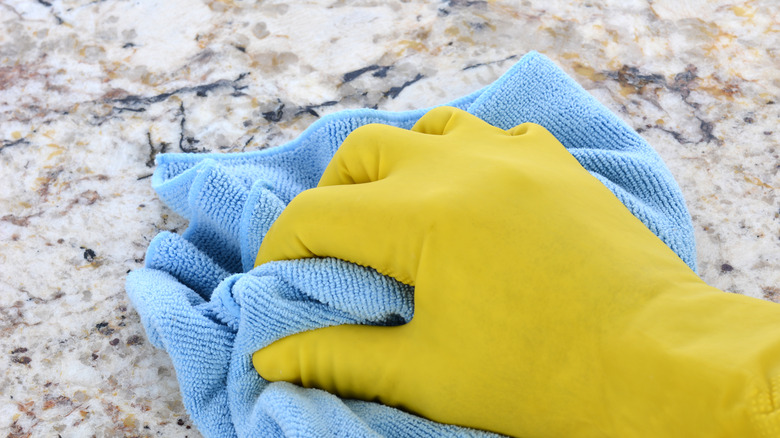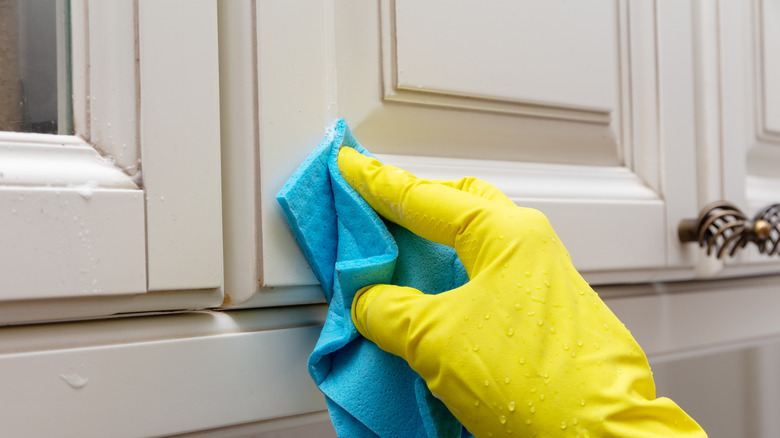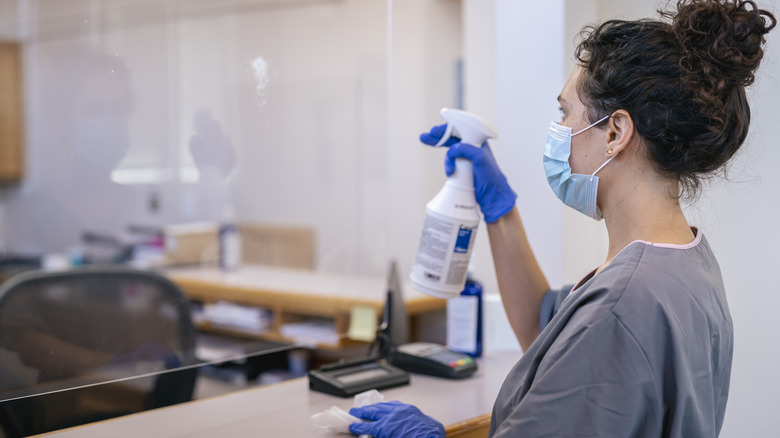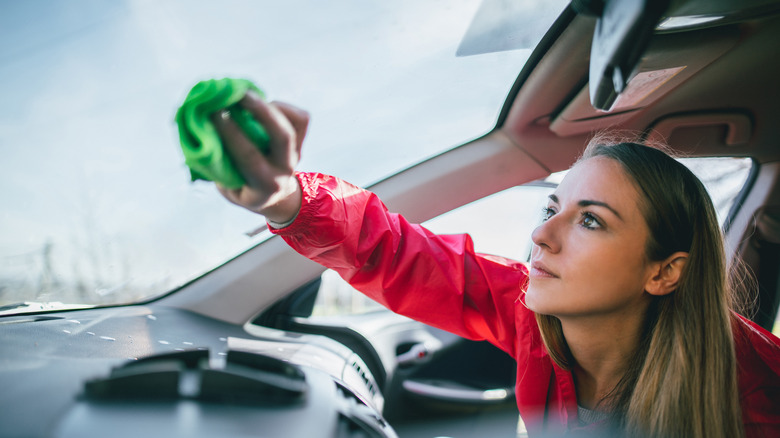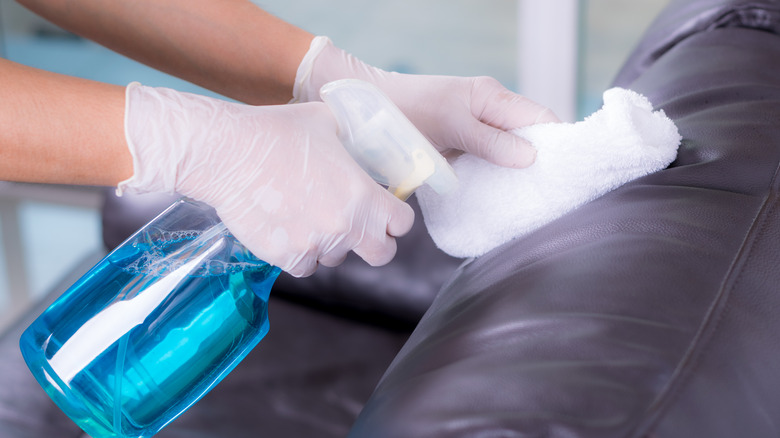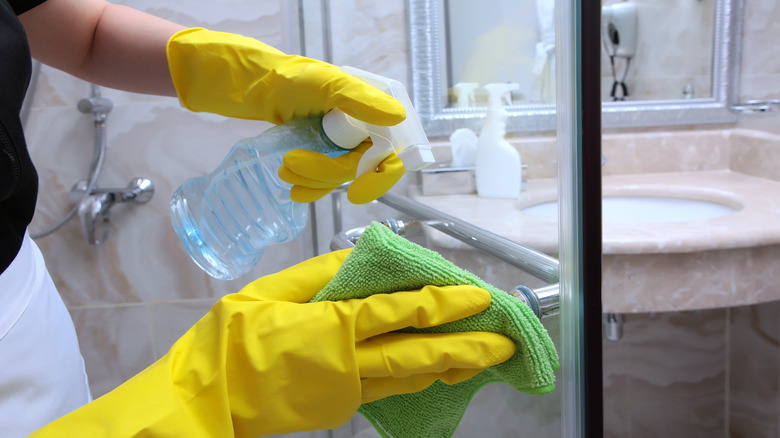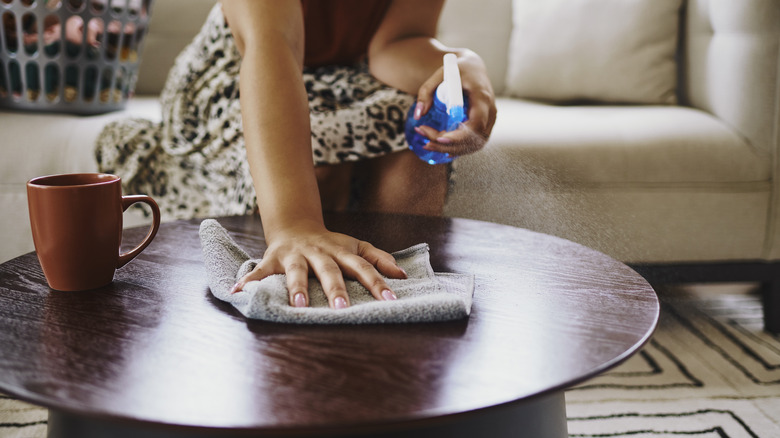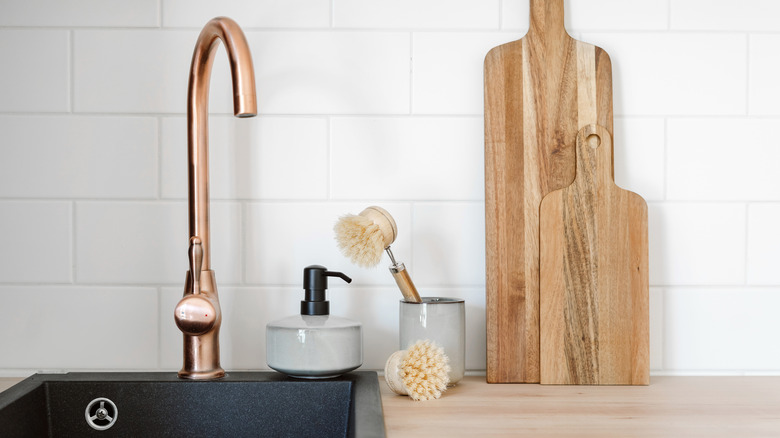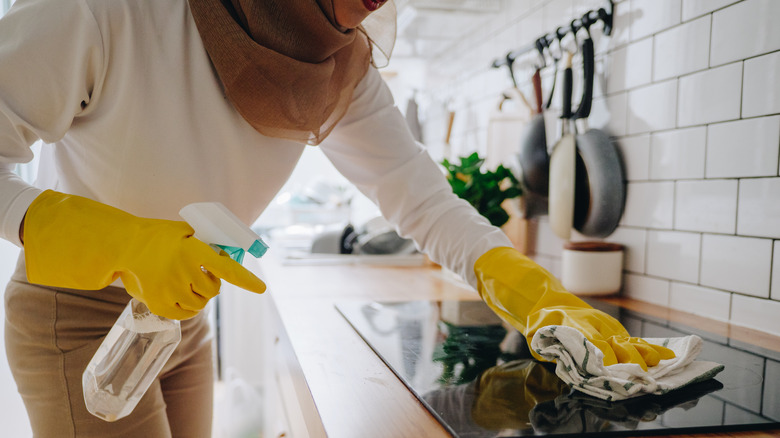Never Clean These 11 Things With Windex. Here's Why
Windex is a versatile cleaner that can be used for much more than just cleaning glass and windows. There are so many surprising ways you can use it around the house. You can use it to clean tiles, walls, patio furniture, jewelry, and even laundry stains. Beyond its uses for cleaning, it can also be used to keep bugs away, lubricate a stuck zipper, and more. However, as versatile as it is, Windex is not an all-purpose cleaner. There are several surfaces and objects around the house that you should not try to clean with it.
Windex contains ammonia, which can damage various surfaces. It may leave a streaky or cloudy appearance, break down finishes, or cause discoloration. Moreover, because ammonia can pose a threat to respiratory health, always use this cleaner with caution and keep it away from children or pets. Ammonia and bleach should never be mixed, either. The combination releases chloramine gas, which can be deadly. Keeping this in mind, here are all the things you shouldn't use Windex to clean.
Avoid cleaning laptop and television screens to protect their delicate components
Many people reach for their bottles of window cleaner to remove streaks, fingerprints, dust, and smudges from their televisions and computer screens. However, doing so isn't a good idea. Windex is formulated with ammonia and alcohol, and using it to clean a laptop screen, computer monitor, or television can damage their LCD screens. The chemicals in the cleaner may also negatively affect the anti-glare coating on the monitor or screen.
Instead, aim to use as little liquid as possible when cleaning these sensitive electronic devices. In most cases, all you'll really need is a dry microfiber cloth. This will allow you to effectively remove dust and debris from the screen without scratching the surface or introducing any liquid to the sensitive components. Before you start wiping down the screen, turn off the unit. You'll be much better able to see fingerprints and other markings against a black screen than one with colors or images.
Windex can harm stainless steel
Using Windex to clean your stainless steel refrigerator, dishwasher, range, or other appliances is not recommended. The ammonia in the ingredient list can have a negative reaction with the stainless steel material, possibly causing it to corrode. In fact, many appliance manufacturers caution against using any abrasive cleaners, like Windex, on their appliances.
When your stainless steel appliances need some TLC, you can grab a canister of wipes specifically designed for cleaning this type of metal. If you have water spots or stuck-on messes, try mixing a little dish soap with hot water. Rub the spot, following the grain, using a microfiber dish cloth dampened with the solution. Whenever you're cleaning stainless steel, it is important always to follow the grain. If you wipe in circles or in the opposite direction, you'll leave streaks on the appliance and end up having to clean it all over again.
Cleaning granite and marble countertops with Windex can damage them
If you have a granite or marble countertop that needs to be cleaned, Windex will not be your best option. While the smooth surface of these materials may feel similar to glass, leading you to think window cleaner will work well on them, you could end up doing a lot more harm than good. Because of its acidity, Windex can dull the surface of your countertop, making it look less glossy. Even worse, it may actually eat into the stone itself, leaving pits across the surface.
The best way to clean a marble or granite countertop is with soap and water. Dip a soft microfiber cloth in a bucket or bowl of warm, soapy water and wipe it over the counter's surface. Rinse with plain water and use a dry towel to remove any excess water from the surface.
Protect the finish on your kitchen cabinets by steering clear of Windex
Unless you have glass windows in your kitchen, you'll probably just want to keep the Windex out of that room altogether. We've already discussed why you shouldn't use it to clean appliances or many countertop materials, but it should also be avoided when cleaning kitchen cabinets. Remember, Windex contains ammonia, which is a very harsh cleaner. Using it on kitchen cabinets — whether wood or painted —- can damage the finish. If your kitchen cabinets have glass insets that you want to clean with Windex, you'll want to exercise extreme caution to avoid letting the glass cleaner drip onto the wood surface below the glass.
All you'll really need to clean the cabinets is a damp microfiber cloth with a drop of dish soap. If something spills or splatters on the cabinets, clean it up quickly to avoid staining or damaging the finish. If you do this and give the surface of each cabinet a quick wipe-down about once a week, you can keep them looking like new.
Windex may make the surface of plexiglass cloudy
It's completely understandable if you've been using Windex to clean plexiglass. After all, the word "glass" is right in its name, so a glass cleaner should be the perfect solution. Unfortunately, that is not the case. Once again, the ammonia and other harsh chemicals found in Windex can damage the material. When plexiglass is cleaned with window cleaner, the surface can turn cloudy and dull. This changed appearance can be permanent, too.
To avoid ruining plexiglass, start by gently blowing away any visible dust or debris on the surface. Then, use a damp microfiber cloth with water and soap to wipe down the surface. You can also use rubbing alcohol or disinfecting wipes. Always make sure that the towel is damp, not dry, before cleaning with it. A dry cloth could push dirt and debris into the surface, leaving behind scratches. Similarly, paper towels should also never be used when cleaning plexiglass. They, too, can scratch the surface.
Car glass cleaned with Windex may have streaks or fog more easily
Did you know the glass used for car windows is different from that used for the windows in your house? Believe it or not, it's true. Because of the differences between these two types of glass, you can't use Windex to clean your windshield or side windows. If you do, the glass could end up streaky or foggy. Beyond the unattractive appearance, both of these conditions actually pose a larger threat to your visibility and safety when driving. Moreover, if the windows in your car are tinted, cleaning them with ammonia could damage the surface. The tint may start to peel over time.
Use a cleaner that is specifically made for auto glass, or make your own by combining equal parts distilled water and alcohol with 1 tablespoon of distilled white vinegar. Spray the cleaning solution on a microfiber cleaning cloth — not the windows themselves — and use even strokes to clean the windows and avoid streaks. Cleaning the outside of windows in a garage or once the sun isn't directly overhead can also help prevent streaks.
Windex can dry leather out
Whether you're talking about a leather couch or a leather pair of shoes, reaching for a bottle of Windex to clean them with is something you shouldn't do. Windex is just too harsh to use on leather surfaces. In addition to the ammonia in the formula, window cleaner also contains alcohol. Alcohol is a drying agent. So, when you use it on your leather, it could cause the surface to become dehydrated and eventually make it crack. Moreover, the Windex may even leave the surface of the leather feeling tacky.
When cleaning leather, start by reading the manufacturer's use and care instructions. Different product types, and even leather types, may require special cleaning methods. In most cases, you'll want to use a cleanser specifically designed for leather. These products will help make sure that the natural oils aren't stripped away, allowing the skin to stay moisturized.
To avoid a streaky finish, don't use Windex on shower doors
Contrary to what you might think, Windex is not the best cleaner for your glass shower doors. While the ammonia in the formula may be effective when cleaning grime off of glass, it isn't always the most effective solution for shower doors. This is because the marks on glass doors are often the result of hard water staining. However, ammonia targets greasy stains, like the fingerprints left behind on glass tables and mirrors. Perhaps the biggest reason not to use Windex on your glass doors has nothing to do with the glass itself. While it may look like the residue from the window cleaner evaporates quickly, there will still be traces of ammonia left behind. These traces can cause damage to metal fixtures, grout, and more.
The next time you need to clean your shower doors, consider making a more natural cleaner using vinegar and water. Combine the two liquids in a 1:2 ratio (1 part vinegar and 2 parts water) to create a DIY shower spray. Spray the solution onto your doors and let it sit for five minutes before wiping the doors clean using a microfiber cloth.
Windex may damage wood furniture or its protective finish
Another thing you won't want to clean using window cleaner is wood furniture. There are actually several ways the various ingredients found in Windex can harm your wood furniture. Wax, lacquer, or varnish are often applied to wooden pieces to help protect the wood and prevent it from losing too much moisture. Cleaning with Windex can cause the finish to break down, which will decrease its moisture content and have a negative impact on the piece's overall appearance. The ammonia in the formula can cause further problems with the piece's aesthetic, discoloring the wood's natural tannins. Because ammonia absorbs water from its surrounding, using cleaners made with it on wood can lead to swelling and warping.
If you have wood furniture that needs to be cleaned, try using a cleaner specially designed for wood. If you don't have anything on hand, you can also use a solution of warm water and a little dish soap. Dip a microfiber cloth in the solution, squeeze out the excess water, and wipe down the surface of the furniture piece. Be sure to follow up by using a dry microfiber cloth to remove any moisture that remains on the surface.
Using Windex to clean copper can discolor its patina
If you have cookware, jewelry, or anything else made of copper, you'll want to avoid using window cleaner. Perhaps you've heard that you can use Windex to clean jewelry. While this may be true for some metals and stones, it is not the case for copper jewelry. Cleaning copper jewelry or other copper pieces with Windex can discolor the patina or finish.
Tarnish on copper that isn't sealed or lacquered can be removed using a little lemon juice or even ketchup. After applying either of these cleaners, follow up by washing the item with warm, soapy water and drying it with a microfiber cloth. Copper that is lacquered will require a bit more TLC when cleaning to avoid causing damage to the coating. Make a DIY cleaner by combining warm water and a little mild dish soap in a spray bottle. Spray the solution directly over the piece, let it sit for about 5 minutes, then scrub away stains and gunk. Be sure to rinse the piece with clean water and then dry it thoroughly using a microfiber cloth.
Windex can leave permanent stains and streaks on a glass stove
Glass cooktops are another surface that many mistakenly think they should clean using Windex. However, while these surfaces are made of glass, they are not the same as a window and should not be cleaned using this method. The glass used to make cooktops is very fragile. Cleaning it with ammonia can lead to streaking or staining that you won't be able to reverse.
When your glass cooktop requires cleaning, you can use distilled white vinegar and baking soda. Spray the entire (cool) surface with the distilled white vinegar and sprinkle some baking soda. Grab a beach towel or bath towel and dampen it with hot water. After squeezing out as much excess water as you can, lay the towel directly over the stovetop and let it sit for about 15 minutes, allowing the humidity to break down the grime. Finish up by wiping down the surface using a microfiber cloth.
